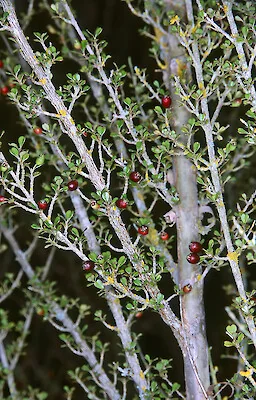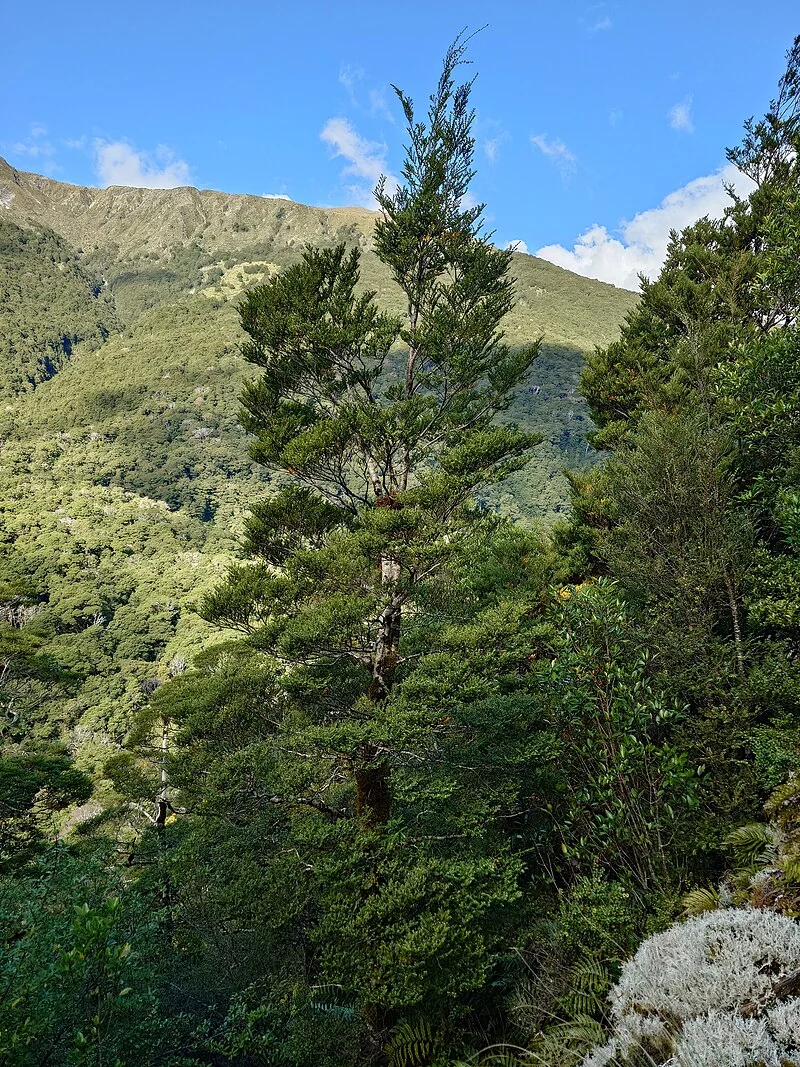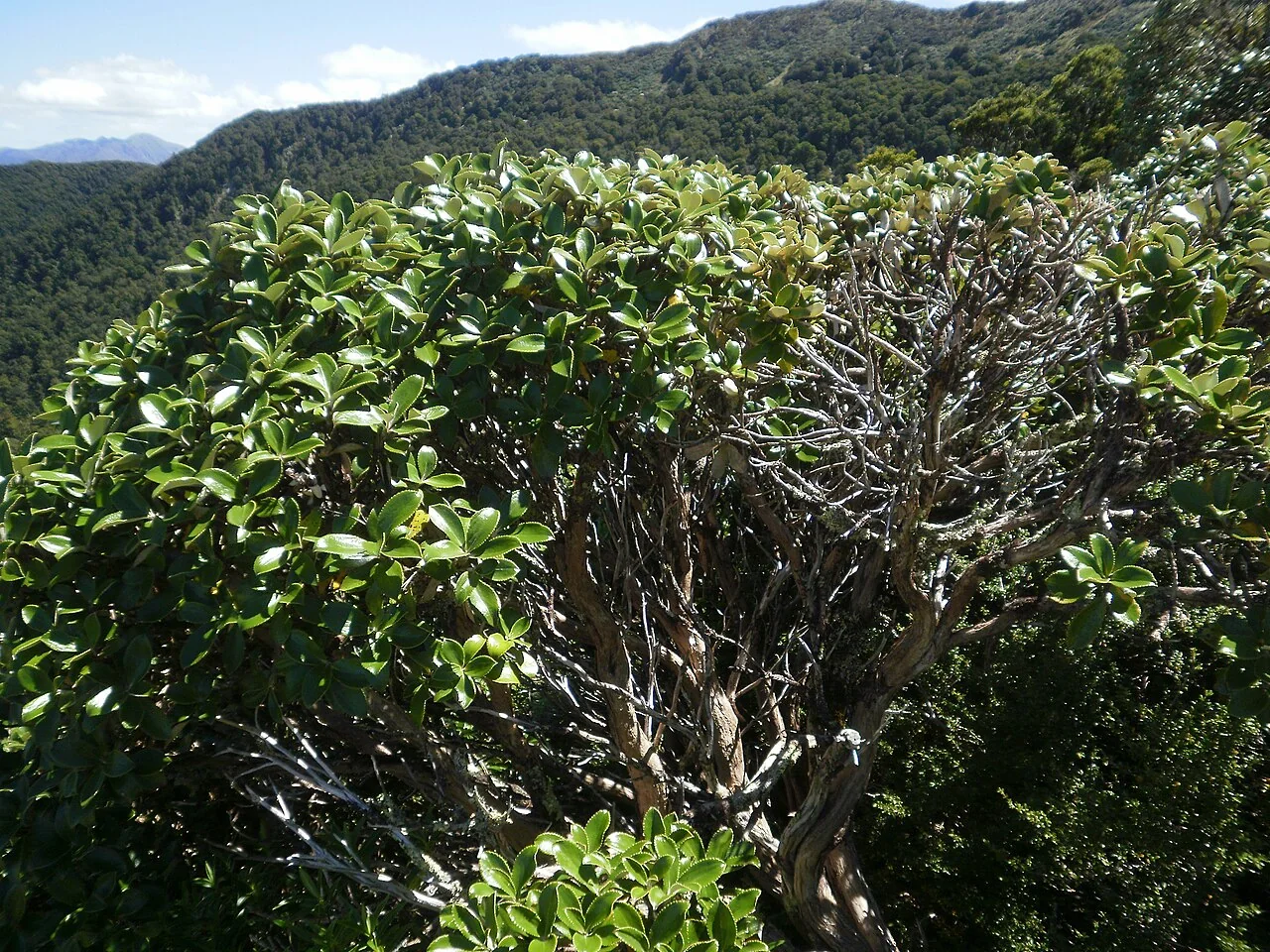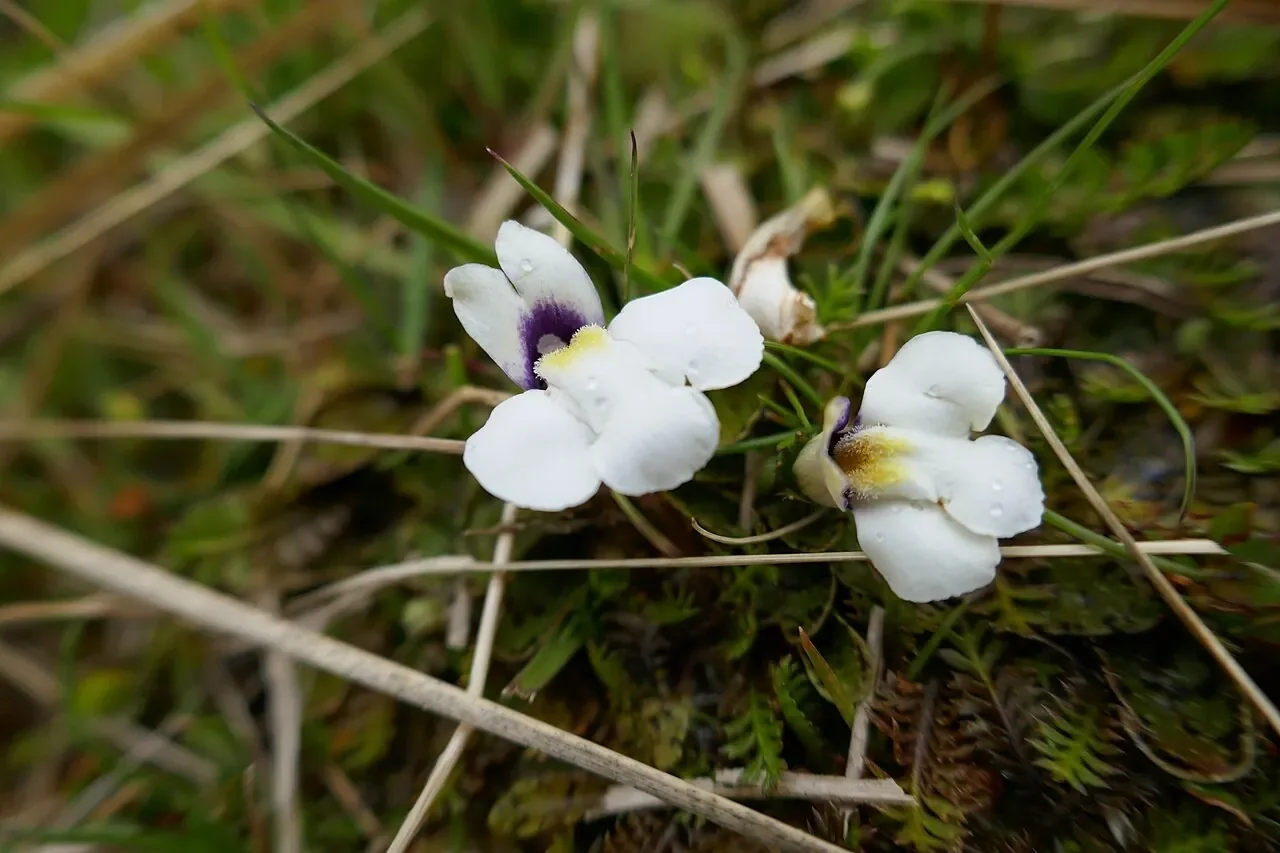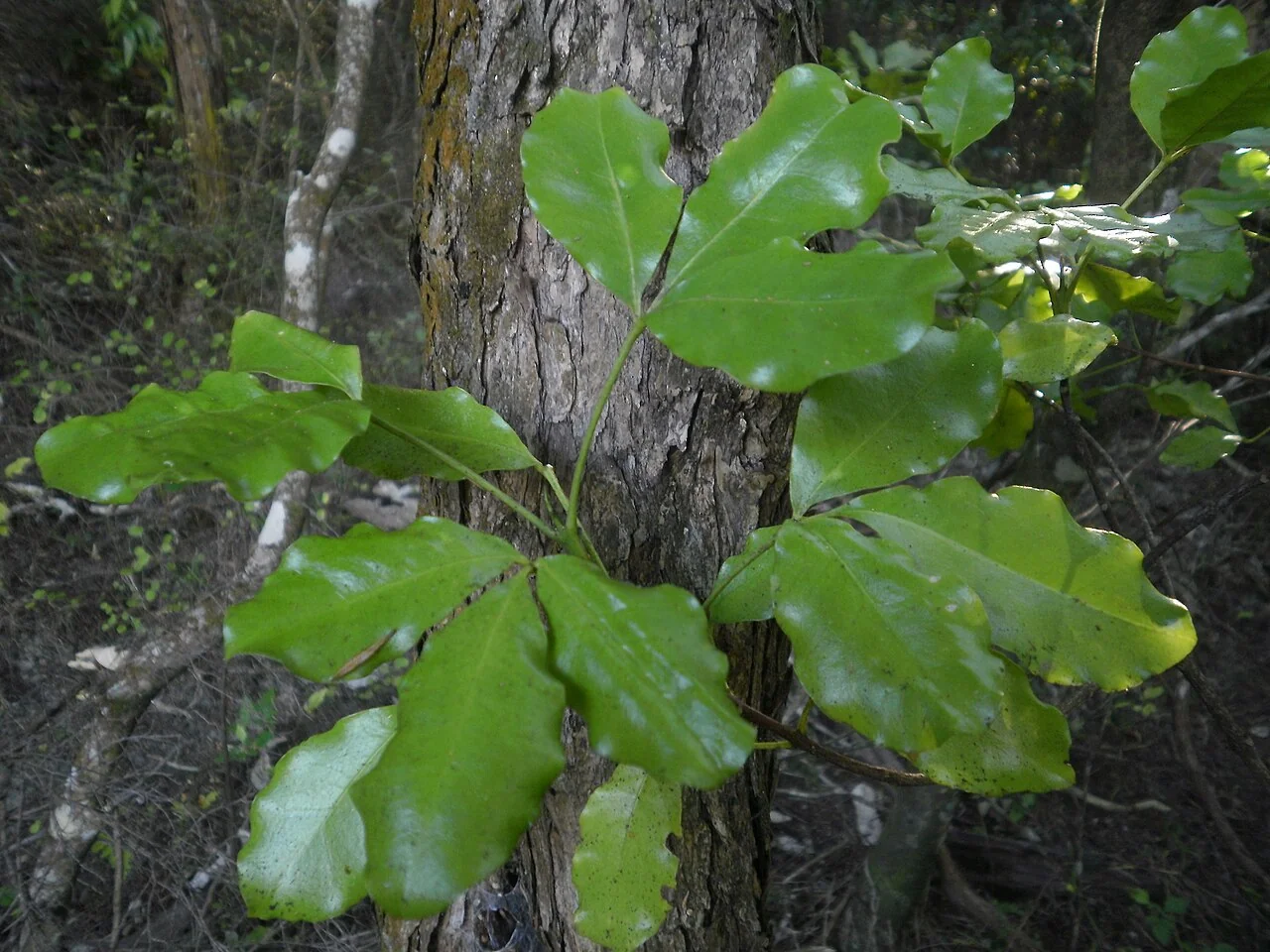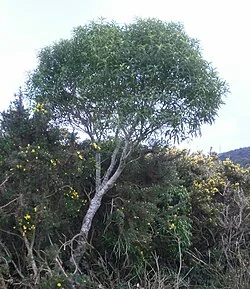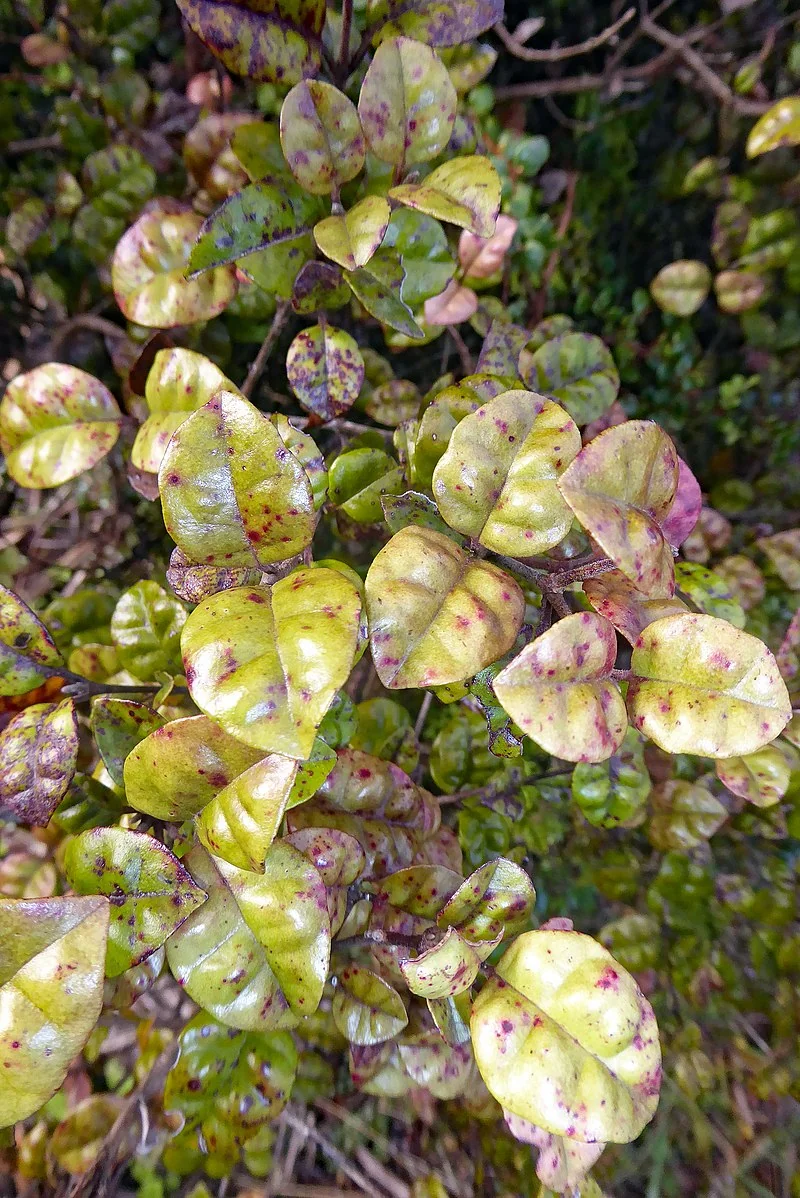
Ramarama
Lophomyrtus bullata
This native plant, known as Ramarama (scientific name: Lophomyrtus bullata), is a remarkable species endemic to New Zealand. It is characterized by its unique features, ecological role, and cultural significance. This comprehensive guide provides detailed information on its care, propagation, and importance within the New Zealand ecosystem. Understanding this plant contributes to the appreciation of our rich biodiversity and heritage. native trees

Plant Description
Botanical Features
Ramarama (Lophomyrtus bullata), also known as Bubble-leaf Shrub, is an evergreen shrub or small tree endemic to New Zealand. It can grow up to 6-8 meters tall and 2-3 meters wide, with a slender trunk and numerous erect, compactly branched reddish branches. Its most distinctive feature is its leaves, which are broadly ovate to suborbicular, thick, leathery, and glossy, with a characteristic puckered or blistered (bullate) appearance between the veins. The leaves vary in color from dark green to yellow-green, often mottled or spotted with red, maroon, or purple-black blemishes, and are paler underneath. It produces small, white, 4-petaled flowers, typically solitary in the leaf axils, followed by broadly ovoid, dark red or black berries that are edible and said to taste like guava when ripe.
Quick Facts
| Scientific Name | Lophomyrtus bullata |
|---|---|
| Height | 15-20 m |
| Spread | 3-5 m |
| Water Needs | Moderate |
| Light | Full sun to part shade |
| Frost Tolerance | Moderate |
| Salt Tolerance | Moderate |
| Growth Rate | Medium |
| Lifespan | Long |
Climate Best Suited to
Ramarama (Lophomyrtus bullata) is primarily found in lowland to hilly forests across the North Island of New Zealand, extending to the Marlborough Sounds in the South Island. It demonstrates good adaptability to various conditions, thriving in areas with well-drained soils and tolerating both full sun and partial shade. Its natural distribution suggests a preference for warmer, more humid environments but with a reasonable tolerance for cooler temperatures found in its southern range.
Regional Suitability
| City | Climate Suitability |
|---|---|
| Whangārei | Ideal |
| Auckland | Ideal |
| Hamilton | Ideal |
| Tauranga | Ideal |
| Rotorua | Ideal |
| Gisborne | Ideal |
| New Plymouth | Ideal |
| Napier | Ideal |
| Whanganui | Ideal |
| Palmerston North | Ideal |
| Wellington | Ideal |
| Nelson | Ideal |
| Christchurch | Ideal |
| Dunedin | Moderate |
| Invercargill | Moderate |
Natural Habitat
Ramarama (Lophomyrtus bullata) is endemic to New Zealand, primarily found in the North Island and occasionally in the northern parts of the South Island. Its natural habitat spans coastal to montane forests and shrublands, often as a noticeable component of the understory in lowland podocarp riparian forests. It can also be found in suitable sites within slope forests and, in wetter areas, is sometimes common in regenerating shrubland in cut-over forests. It thrives in well-drained, fertile soil and prefers full sun to partial shade, tolerating wind, light frosts, and moderate exposure.
Plant Conservation
Lophomyrtus bullata, commonly known as ramarama or New Zealand myrtle, is an evergreen shrub endemic to New Zealand. Its conservation status is currently classified as "At Risk - Declining" by the New Zealand Threat Classification System. This status was elevated to "Threatened - Nationally Critical" in 2017/2018, primarily due to the severe impact of myrtle rust (Austropuccinia psidii), a pathogenic fungus that arrived in New Zealand in 2017. This rust can infect over 70% of plants in some areas, affecting leaves, stems, and flowers, and significantly impacts the plant's reproductive success, potentially leading to functional extinction in certain regions. Other contributing factors to its vulnerability include habitat loss from urban development, agricultural expansion, and deforestation, as well as competition from invasive plant species. Conservation efforts involve both in-situ and ex-situ strategies, including protecting existing populations, restoring native vegetation, cultivating the plant in botanical gardens to preserve genetic material, and ongoing research and monitoring.
Growing Requirements
Soil Requirements
Ramarama (Lophomyrtus bullata) is remarkably adaptable to different soil conditions, thriving in well-drained environments. It can tolerate a variety of soil types, from sandy to loamy, and prefers a neutral to slightly acidic pH. Good drainage is crucial to prevent root rot, ensuring healthy growth and development.
- Tolerates a wide range of soil types from clay to sandy
- Prefers well-draining soils but can handle occasional waterlogging
- Thrives in moderately fertile soils but will grow in poor soils too
- Can tolerate slightly acidic to slightly alkaline pH
- Handles coastal conditions including salt spray
Light Requirements
Ramarama (Lophomyrtus bullata) thrives in a variety of light conditions, from full sun to partial shade. Optimal growth and flowering are typically achieved in locations receiving ample sunlight throughout the day. However, it can also tolerate some shade, especially in hotter climates, where it benefits from protection during the most intense afternoon sun.
- Full sun for optimal growth and form
- Can tolerate partial shade but may develop a leggier form
- At least 6 hours of direct sunlight daily is ideal
- Northern or eastern exposures work well in garden settings
Water Requirements
Once established, Ramarama (Lophomyrtus bullata) is remarkably drought-tolerant, requiring minimal supplemental watering. During its establishment phase, consistent moisture is crucial to encourage strong root development. Mature plants can withstand dry periods, but regular watering during prolonged droughts will promote healthier growth and more abundant flowering.
- Moderate watering during establishment (first 1-2 years)
- Drought-tolerant once established
- Can handle periods of soil saturation
- Reduce watering in winter when growth slows
- Signs of overwatering include yellowing leaves and crown rot
Planting Guide
Ramarama is a versatile and attractive shrub that is relatively easy to grow in a garden setting. Its unique, textured leaves and colourful foliage make it a popular choice for adding interest and structure to a planting scheme.
Site Selection
- Light: Ramarama thrives in full sun to partial shade. The leaf colour is often more intense in a sunnier position.
- Soil: This plant prefers a moist, well-draining soil. It is adaptable to a range of soil types, but will not tolerate waterlogged conditions.
- Shelter: A sheltered position is preferable, especially in colder regions, to protect the plant from frost and strong winds.
Planting Instructions
- Timing: Plant in autumn or spring to allow the plant to establish before the extremes of summer or winter.
- Planting: Dig a hole that is twice the width of the root ball. Gently place the plant in the hole, ensuring it is planted at the same depth as it was in its container. Backfill with soil and water in well.
Ongoing Care
- Watering: Water regularly during the first year of establishment. Once established, Ramarama is reasonably drought-tolerant, but will benefit from a deep watering during prolonged dry spells.
- Pruning: Prune to shape as desired. Ramarama responds well to pruning and can be maintained as a compact shrub or hedge.
- Pests and Diseases: Ramarama is susceptible to myrtle rust. Plant in a position with good air circulation and monitor for signs of the disease.
Ecological Role
Ramarama (Lophomyrtus bullata) strengthens forest edges and riparian margins. As a myrtle, it couples nectar- and fruit-production with dense, wind-buffering structure.
Pollination and Dispersal
- Pollinator resource: White blooms provide nectar and pollen for insects through spring-summer flushes.
- Bird vectors: Fleshy berries are dispersed by birds, extending populations between forest patches.
Habitat Engineering
- Edge buffering: Dense foliage reduces understorey wind and desiccation, protecting ferns and seedlings.
- Litter and soil: Evergreen leaf-fall sustains decomposers, improving soil organic matter and moisture retention.
Resilience and Risks
- Site tolerance: Thrives from lowland bush to damp gullies, adding structural continuity across habitats.
- Myrtle rust awareness: Potential susceptibility to Austropuccinia psidii makes spacing and airflow important in plantings.
By feeding pollinators and frugivores while buffering microclimates, ramarama enhances biodiversity and ecological connectivity.
Uses and Significance
Garden Uses
- Specimen tree for visual impact
- Suitable for native gardens and restoration projects
- Enhances native garden aesthetics and biodiversity
- Provides architectural accent with its unique structure
- Effective for erosion control on slopes and banks
Landscaping Uses
Ramarama is a highly valued plant in horticulture, prized for its unique, textured foliage and its vibrant, colourful leaves. It is a versatile shrub that can be used in a variety of ways to add interest and structure to a garden.
Key Landscaping Applications:
- Specimen Plant: The distinctive, puckered leaves of Ramarama make it an excellent specimen plant. Its interesting texture and the reddish-purple blotches on its leaves provide year-round visual interest.
- Hedging and Screening: Ramarama can be pruned to form a dense hedge or screen. Its compact growth habit and attractive foliage make it a great choice for creating privacy or dividing garden spaces.
- Mixed Borders: The colourful foliage of Ramarama provides a wonderful contrast to other plants in a mixed border. It can be used to add a splash of colour and texture to a planting scheme.
- Native Plantings: As a native plant, Ramarama is an excellent choice for a native garden or restoration project. It provides food and habitat for native birds and insects.
It is important to note that Ramarama is susceptible to myrtle rust. To minimise the risk of infection, plant it in a position with good air circulation and avoid overhead watering.
Seasonal Care Calendar
Spring
In spring, Ramarama (Lophomyrtus bullata) begins its active growth phase. New foliage emerges, and it's an ideal time for planting new specimens or propagating. Ensure adequate moisture and monitor for early signs of pests.
- New growth begins with fresh foliage development
- Apply a balanced, slow-release fertilizer if desired
- Excellent time for planting new specimens or dividing offsets
- Monitor for new pest activity and address promptly
Summer
Summer is the peak growing season for Ramarama (Lophomyrtus bullata), often accompanied by flowering. Consistent watering is important, especially for young plants, to support vigorous growth and prevent stress during dry periods.
- Flowering typically occurs in early to mid-summer (November-January)
- Water young trees regularly during extended dry periods
- Avoid heavy pruning during the active growing season
Autumn
During autumn, Ramarama (Lophomyrtus bullata) prepares for the cooler months. Fruits or berries develop, providing food for native birds. It's also a good time for planting and general garden cleanup.
- Fruits or berries develop and ripen (December-February), attracting birds
- Natural leaf shedding occurs as part of its growth cycle
- Good time for planting new specimens to establish before winter
- Clean up fallen leaves if a tidy appearance is desired
Winter
Winter is generally a dormant period for Ramarama (Lophomyrtus bullata). Minimal care is required, though young plants may benefit from protection in colder regions. This is an opportune time for any necessary structural pruning.
- Generally dormant with minimal growth activity
- No special winter protection needed in most mild climates
- Suitable time for structural pruning if required
- Fallen leaves can be left as mulch or removed for tidiness
When to Prune and How Much
Ramarama (Lophomyrtus bullata) generally requires minimal pruning to maintain its natural form and health. Pruning should focus on removing dead or damaged growth and shaping the plant as needed.
- Remove dead, damaged, or diseased branches at any time of year
- Light formative pruning when young helps establish good structure
- To create a multi-trunked specimen, cut the main stem to encourage branching
- Fallen leaves can be removed for a tidier appearance, or left as natural mulch
- If necessary, lower branches can be removed to create clearance underneath
- Major pruning is best done in late winter to early spring before new growth
Always use clean, sharp tools for pruning to minimize the risk of disease and ensure clean cuts. The plant often responds well to pruning with vigorous new growth, contributing to a fuller, healthier appearance.
How to Grow Ramarama
From Seed
Propagating Ramarama (Lophomyrtus bullata) from seed is a rewarding process, though it requires patience. Start by collecting seeds from the ripe, dark berries in autumn. Clean the flesh from the seeds before sowing. Sow the seeds in a deep seed tray filled with a well-draining seed-raising mix. Cover them lightly with about 5mm of the mix or fine gravel. Water the tray gently and place it in a warm, sheltered spot with bright, indirect sunlight. Germination can be slow, taking several months. It is crucial to maintain consistent moisture levels without waterlogging the soil. Once the seedlings are large enough to handle, carefully prick them out into individual pots. Use a deep pot to accommodate the plant's developing taproot. Grow them on for a year or two before planting them in their final position.
From Cuttings
Ramarama can also be grown from semi-hardwood cuttings, which is a faster method than growing from seed and ensures the new plant is true to the parent. Take cuttings in late summer or early autumn from healthy, vigorous shoots of the current season's growth. Cuttings should be about 10-15cm long and taken from a node. Remove the leaves from the lower half of the cutting to reduce water loss and dip the base in a rooting hormone to encourage root development. Insert the cuttings into a container filled with a free-draining potting mix, such as a mix of peat and sand. Place the container in a warm, humid environment, like a propagator or under a clear plastic bag, to maintain high humidity. Keep the mix moist but not waterlogged. Roots should form within a few months. Once the cuttings have a well-developed root system, they can be potted on into larger containers and grown until they are robust enough to be planted out in the garden.
Planting
When planting your Ramarama, choose a site with well-drained soil and a sunny or partially shaded aspect. While it is adaptable to a range of conditions, it thrives in a cooler, moist root run. Before planting, prepare the site by digging a hole that is twice the width of the root ball and just as deep. Gently tease out the roots of the plant to encourage them to grow outwards into the surrounding soil. Place the plant in the hole, ensuring that it is at the same depth as it was in the pot. Backfill with soil and firm it down gently. Water the plant thoroughly after planting to settle the soil and eliminate any air pockets. It is important to keep the soil moist, especially during dry periods, until the plant is well-established. Applying a layer of organic mulch around the base of the plant will help to retain moisture, suppress weeds, and provide nutrients as it breaks down.
Pests and Diseases
Myrtle Rust Awareness
Ramarama (Lophomyrtus bullata) belongs to the myrtle family and can be highly susceptible to myrtle rust (Austropuccinia psidii) in warm, humid conditions. Young flushing growth is most at risk.
- Symptoms: Bright yellow/orange powdery pustules on new leaves, shoots, and flower parts; deformation and dieback of soft tissues.
- Hygiene: Avoid clipping during active flushes; sterilise tools; dispose of infected material in landfill waste (do not compost).
- Airflow: Provide good spacing and prune to open the canopy to reduce humidity.
- Monitoring: Check frequently in late spring to autumn; act early when new lesions appear.
Other Issues
- Scale and sooty mould: Manage with horticultural oils and improved airflow.
- Leaf scorch: Hot, dry winds can brown the distinctive blistered leaves; site with some shelter.
- Waterlogging: Avoid heavy, saturated soils to prevent root stress and dieback.
Cultural Significance
Lophomyrtus bullata, commonly known by its Māori name ramarama, holds significant cultural importance, particularly in New Zealand.
Key Aspects of Cultural Significance Include:
- Traditional Māori Uses: The leaves of the ramarama were traditionally used by Māori for medicinal purposes, including treating cuts, ulcers, wounds, and bruises. This is attributed to an antiseptic comāpound, bullatenone, found uniquely in the plant. The plant's hard, dense wood was also valued for crafting adze handles and poles for watercraft.
- Food Source: In times of scarcity, the small, dark red to black berries of the ramarama were consumed, often alongside aruhe (fern root). Some accounts describe the fruits and seeds as having a pleasant, aromatic taste, similar to guava.
- Linguistic and Symbolic Connections: The name "ramarama" is also applied to another native New Zealand plant, Pseudowintera colorata (horopito). Both plants share this name due to the way their vibrant leaves reflect light. Furthermore, ramarama was chosen by biblical translators to represent the Middle Eastern Myrtus communis (hadas in Hebrew) in Māori texts, likely due to its similar appearance and preference for damp habitats.
- Geographical Naming: The plant's name has also been adopted for geographical locations, such as the rural community of Ramarama in the Auckland Region of New Zealand. This area has historical significance, including a pā site once inhabited by the Ngāti Pou tribe.
Bonus Tip
Ramarama (Lophomyrtus bullata) is prone to myrtle rust in some regions. Avoid clipping during warm, humid weather when new flushes are soft. Instead, prune lightly in late winter and feed modestly to reduce overly lush growth. Good airflow around the crown lowers infection pressure while keeping its blistered foliage pristine.
